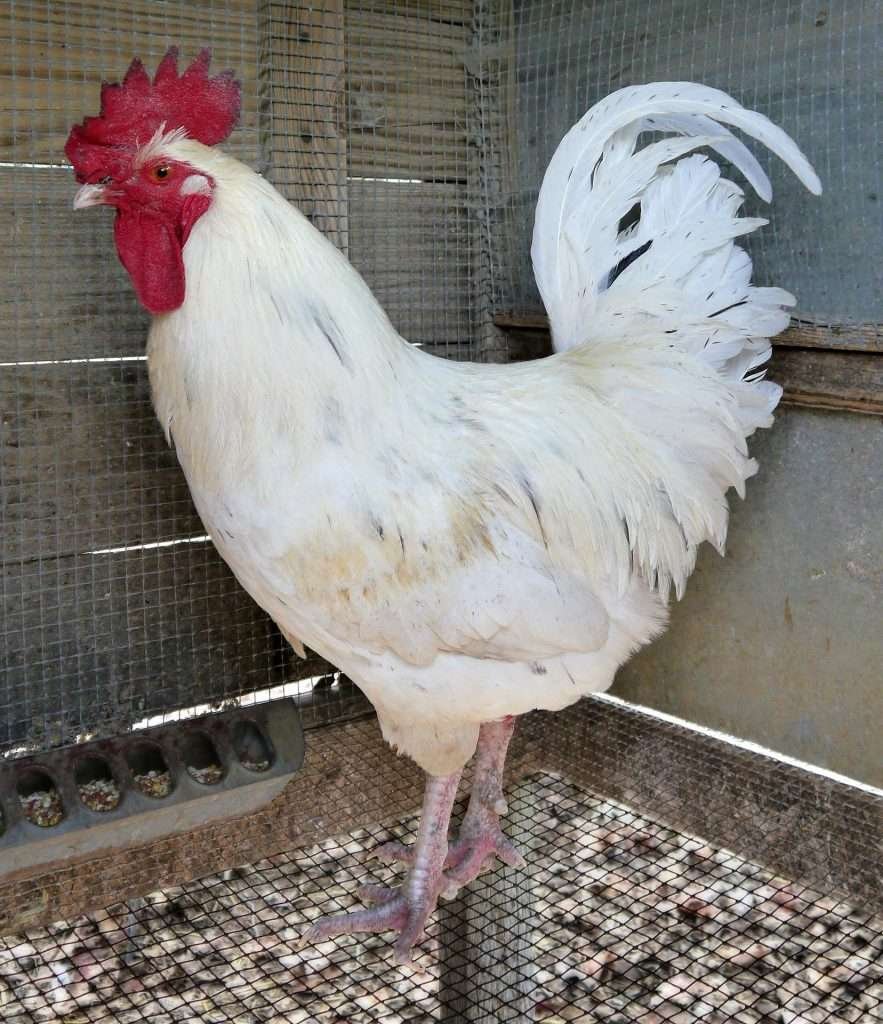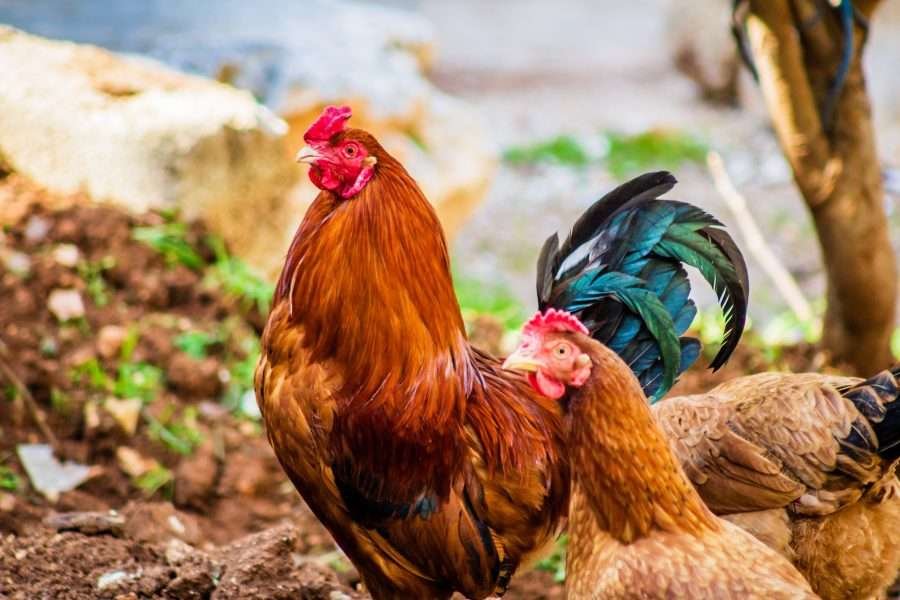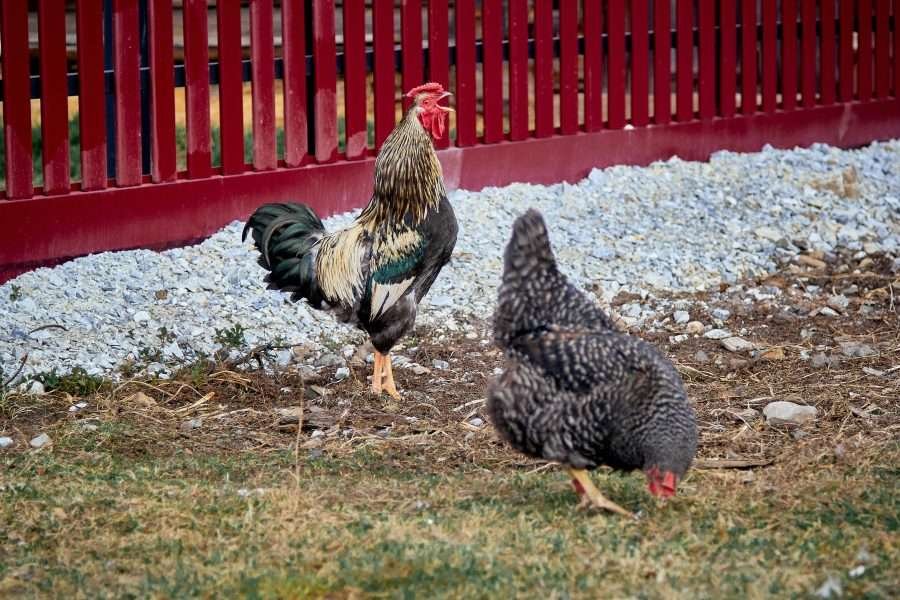If you are interested in raising chickens, you might wonder how to tell the difference between a rooster chicken and a hen chicken. A rooster is a male chicken, while a hen is a female chicken. They belong to the same species, but they have distinct physical and behavioral characteristics that set them apart. Knowing how to identify a rooster from a hen can help you plan your flock, manage your eggs, and avoid unwanted surprises.

In this article, we will explain the main differences between roosters and hens in terms of appearance, behavior, and life cycle.
We will also provide some easy ways to tell them apart using their feathers, combs, wattles, legs, and egg-laying abilities.
By the end of this article, you will be able to confidently distinguish a rooster chicken from a hen chicken and enjoy your chicken-keeping experience.
What this article covers
This is a long article, so below are some quick links. Click any of them to go straight to that section – or just carry on reading for the full guide!
Pros and Cons of Keeping a Rooster
Rooster and Hen Chickens For Sale
Shopping list of items needed to look after a Rooster or Hen
Appearance
One of the most obvious ways to tell a rooster from a hen is by looking at their appearance. Roosters and hens have different body shapes, sizes, colors, and feather patterns that make them stand out from each other. Here are some of the main features that you can use to identify a rooster or a hen:
Comb and wattles: The comb is the fleshy red crest on top of a chicken’s head, while the wattles are the elongated red flaps that hang under the beak. Both sexes have them, but roosters tend to have larger, brighter, and more prominent combs and wattles than hens. This is because they use them to attract mates and intimidate rivals. The comb and wattles also help chickens regulate their body temperature by releasing excess heat.
Feathers: The feathers of a chicken cover most of its body and provide insulation, protection, and camouflage. Roosters and hens have different types of feathers that reflect their roles and functions. Roosters usually have more colorful and iridescent feathers than hens, especially on their necks (hackle feathers), backs (saddle feathers), and tails (sickle feathers).
These feathers are longer, pointier, and showier than those of hens, and they help roosters display their dominance and attractiveness. Hens, on the other hand, have more subdued and duller feathers than roosters, especially on their chests (breast feathers), wings (wing feathers), and tails (tail feathers). These feathers are shorter, rounder, and plainer than those of roosters, and they help hens blend in with their surroundings and avoid predators.
Size: The size of a chicken depends on its breed, age, diet, and health. However, in general, roosters are larger and heavier than hens. Roosters have bigger heads, chests, shoulders, legs, and feet than hens. They also have longer necks and beaks than hens. The average weight of a rooster is about 6 pounds (2.7 kg), while the average weight of a hen is about 4 pounds (1.8 kg).

Behaviours
Roosters and hens are both chickens, but they have different roles and personalities that make them unique. Roosters are male chickens, while hens are female chickens. They belong to the same species, Gallus gallus domesticus, but they have different behavioral traits that distinguish them from each other.
Roosters are more aggressive, assertive, and dominant than hens. They use their combs, wattles, feathers, spurs, and crowing to attract mates and intimidate rivals. They also protect their flock from predators and other threats. Roosters tend to be bossy, even when they are young. As they get older, they begin to challenge each other, raising their hackle feathers. They also establish a pecking order among themselves and the hens. Roosters are usually loyal to their flock and will defend it with their lives.
Hens are more timid, social, and friendly than roosters. They use their feathers, clucking, and pecking to communicate and bond with their flock. They also lay and incubate eggs and raise chicks. Hens tend to be more submissive than roosters. They follow the rooster’s lead and respect his authority. They also form friendships with other hens and share nesting boxes. Hens are usually attentive to their chicks and will teach them how to forage and behave.

Life Cycle
The life cycle of a rooster or a hen can be divided into three stages: chick, adolescent, and adult. Each stage has its own features and challenges that roosters and hens have to face.
Chick
A chick is a baby chicken that hatches from an egg. The egg can be fertilized or unfertilized. A fertilized egg is an egg that has been mated by a rooster and contains an embryo. An unfertilized egg is an egg that has not been mated by a rooster and does not contain an embryo.
A fertilized egg takes about 21 days to hatch, while an unfertilized egg does not hatch at all. A hen can lay both types of eggs, but only fertilized eggs can produce chicks. A rooster does not lay eggs at all.
A chick hatches with a soft downy coat of feathers that provides warmth and protection. A chick can be either male or female, but it is very difficult to tell them apart at this stage. Some methods of sexing chicks include vent sexing, wing feather sexing, behavior observation, and DNA testing.
A chick needs to be kept warm, fed, watered, and protected from predators and diseases. A chick can follow its mother hen or be raised by humans in a brooder.
Adolescent
An adolescent is a young chicken that is between one month and one year old. This is the stage where roosters and hens start to develop their distinctive features and personalities.
A rooster starts to grow larger and more colorful than a hen. He develops a larger comb and wattles, longer and pointier hackle, saddle, and sickle feathers, thicker legs and feet, and sharp spurs on his legs. He also starts to crow and challenge other males for dominance and mating rights.
A hen starts to grow smaller and more subdued than a rooster. She develops a smaller comb and wattles, shorter and rounder breast, wing, and tail feathers, thinner legs and feet, and no spurs on her legs. She also starts to lay eggs and incubate them if they are fertilized.
An adolescent needs to be fed, watered, sheltered, and vaccinated. An adolescent also needs to establish its place in the pecking order of the flock.
Adult
An adult is a mature chicken that is over one year old. This is the stage where roosters and hens perform their main roles and functions.
A rooster is the leader and protector of the flock. He mates with the hens, guards them from predators and intruders, alerts them of danger, finds food for them, and settles disputes among them. He also crows to mark his territory and announce his presence.
A hen is the producer and nurturer of the flock. She lays eggs regularly, broods them if they are fertilized, hatches them into chicks, teaches them how to forage and behave, cares for them until they are independent. She also clucks to communicate with her flock mates.
Pros and Cons of Keeping a Rooster Chicken
Here are some pros and cons of keeping a rooster chicken:
Pros:
- A rooster can fertilize the eggs of the hens, allowing you to hatch your own chicks and expand your flock.
- A rooster can protect the hens from predators and intruders, such as hawks, foxes, dogs, or other roosters.
- A rooster can alert the hens of danger and lead them to safety, using his crowing and body language.
- A rooster can find food for the hens and share it with them, using his clucking and pecking.
- A rooster can add beauty and diversity to your flock, with his colorful and iridescent feathers.
Cons:
- A rooster can be noisy and annoying, especially in the early morning or throughout the day. His crowing can disturb you and your neighbors.
- A rooster can be aggressive and territorial, especially during the breeding season. He can attack you, your children, your pets, or other roosters. He can also injure the hens with his spurs or beak.
- A rooster can be unwanted and illegal, depending on where you live. Some areas have laws or regulations that prohibit or limit the number of roosters you can keep.
- A rooster can be costly and wasteful, as he does not produce eggs or meat. He also consumes more feed than a hen and may require more space and shelter.
- A rooster can be difficult to rehome or cull, if you decide you do not want him anymore. He may not be accepted by other flocks or shelters. He may also have sentimental value to you or your family.

Rooster and Hen Chickens For Sale
Cackle Hatchery supplies and delivers over 200 varieties of rooster chicken breeds. Check out current supplies for Roosters here.
Shopping list of items needed to look after a Rooster or Hen:
- Chicken coop
- Wood shavings bale
- Feeder
- Waterer
- Perch
- Nesting Box
- Layer pellets
- Chicken scratch/grain
- Shell grit
- Chicken Safe Disinfectant
- Coop cleaner
- Chicken dust
- Wormer
- Multivitamin
- Calcium supplement
- Insecticide
- Mealworms
Chicken Care Shopping List
Are you looking for a shopping list of everything you need when caring for your precious flock? We have put together an easy reference of items for your convenience.

